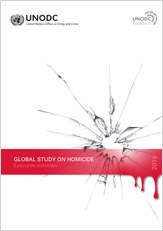 UNODC
UNODC
Overview: The Global Study on Homicide is a search for solutions. By bringing together the available data, the United Nations Office on Drugs and Crime seeks to shed light on different phenomena, from lethal gang violence and the role of firearms to links with inequalities and gender-related killings, and in this way support targeted action. I hope that the research and analysis contained in the study are used in this spirit – not to designate “murder capitals” but to learn, understand and strengthen prevention.
Criminal activity is responsible for many more deaths worldwide than armed conflict and terrorism combined. Unless the international community takes decisive steps, targets under Sustainable Development Goal 16 to significantly reduce all forms of violence and related death rates by 2030 will not be met.
The Americas continue to report high homicide rates. Young men are especially at risk, with a homicide rate for men aged 18 to 19 estimated at 46 per 100,000 – far higher than the risk faced by their peers in other regions. Firearms are also involved far more often in homicides in the Americas than in other parts of the world.
By contrast, Europe has seen a decline in the homicide rate by 63 per cent since 2002 and by 38 per cent since 1990. The rate in Asia has fallen by 36 per cent since 1990. Data collection overall has improved since the previous Global Study on Homicide, but there remain serious gaps in the availability of reliable data for African countries. There are also indications that homicide is underreported in the official statistics in Pacific countries.
